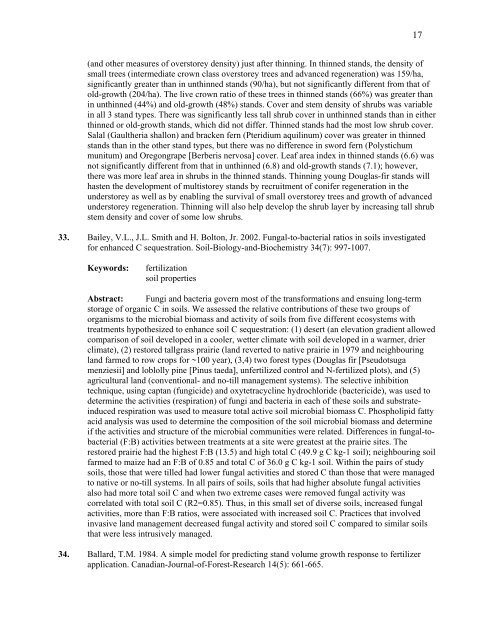IntensIve sIlvIculture - Forest Science Labs - Research Network ...
IntensIve sIlvIculture - Forest Science Labs - Research Network ...
IntensIve sIlvIculture - Forest Science Labs - Research Network ...
You also want an ePaper? Increase the reach of your titles
YUMPU automatically turns print PDFs into web optimized ePapers that Google loves.
(and other measures of overstorey density) just after thinning. In thinned stands, the density of<br />
small trees (intermediate crown class overstorey trees and advanced regeneration) was 159/ha,<br />
significantly greater than in unthinned stands (90/ha), but not significantly different from that of<br />
old-growth (204/ha). The live crown ratio of these trees in thinned stands (66%) was greater than<br />
in unthinned (44%) and old-growth (48%) stands. Cover and stem density of shrubs was variable<br />
in all 3 stand types. There was significantly less tall shrub cover in unthinned stands than in either<br />
thinned or old-growth stands, which did not differ. Thinned stands had the most low shrub cover.<br />
Salal (Gaultheria shallon) and bracken fern (Pteridium aquilinum) cover was greater in thinned<br />
stands than in the other stand types, but there was no difference in sword fern (Polystichum<br />
munitum) and Oregongrape [Berberis nervosa] cover. Leaf area index in thinned stands (6.6) was<br />
not significantly different from that in unthinned (6.8) and old-growth stands (7.1); however,<br />
there was more leaf area in shrubs in the thinned stands. Thinning young Douglas-fir stands will<br />
hasten the development of multistorey stands by recruitment of conifer regeneration in the<br />
understorey as well as by enabling the survival of small overstorey trees and growth of advanced<br />
understorey regeneration. Thinning will also help develop the shrub layer by increasing tall shrub<br />
stem density and cover of some low shrubs.<br />
33. Bailey, V.L., J.L. Smith and H. Bolton, Jr. 2002. Fungal-to-bacterial ratios in soils investigated<br />
for enhanced C sequestration. Soil-Biology-and-Biochemistry 34(7): 997-1007.<br />
Keywords: fertilization<br />
soil properties<br />
Abstract: Fungi and bacteria govern most of the transformations and ensuing long-term<br />
storage of organic C in soils. We assessed the relative contributions of these two groups of<br />
organisms to the microbial biomass and activity of soils from five different ecosystems with<br />
treatments hypothesized to enhance soil C sequestration: (1) desert (an elevation gradient allowed<br />
comparison of soil developed in a cooler, wetter climate with soil developed in a warmer, drier<br />
climate), (2) restored tallgrass prairie (land reverted to native prairie in 1979 and neighbouring<br />
land farmed to row crops for ~100 year), (3,4) two forest types (Douglas fir [Pseudotsuga<br />
menziesii] and loblolly pine [Pinus taeda], unfertilized control and N-fertilized plots), and (5)<br />
agricultural land (conventional- and no-till management systems). The selective inhibition<br />
technique, using captan (fungicide) and oxytetracycline hydrochloride (bactericide), was used to<br />
determine the activities (respiration) of fungi and bacteria in each of these soils and substrateinduced<br />
respiration was used to measure total active soil microbial biomass C. Phospholipid fatty<br />
acid analysis was used to determine the composition of the soil microbial biomass and determine<br />
if the activities and structure of the microbial communities were related. Differences in fungal-tobacterial<br />
(F:B) activities between treatments at a site were greatest at the prairie sites. The<br />
restored prairie had the highest F:B (13.5) and high total C (49.9 g C kg-1 soil); neighbouring soil<br />
farmed to maize had an F:B of 0.85 and total C of 36.0 g C kg-1 soil. Within the pairs of study<br />
soils, those that were tilled had lower fungal activities and stored C than those that were managed<br />
to native or no-till systems. In all pairs of soils, soils that had higher absolute fungal activities<br />
also had more total soil C and when two extreme cases were removed fungal activity was<br />
correlated with total soil C (R2=0.85). Thus, in this small set of diverse soils, increased fungal<br />
activities, more than F:B ratios, were associated with increased soil C. Practices that involved<br />
invasive land management decreased fungal activity and stored soil C compared to similar soils<br />
that were less intrusively managed.<br />
34. Ballard, T.M. 1984. A simple model for predicting stand volume growth response to fertilizer<br />
application. Canadian-Journal-of-<strong>Forest</strong>-<strong>Research</strong> 14(5): 661-665.<br />
17
















